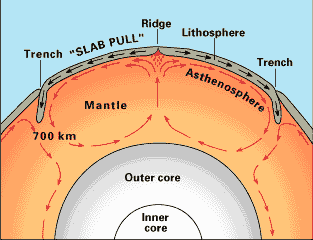mid-ocean ridge

How ocean trenches and mid-ocean ridges are formed. Credit: U.S. Geological Survey.
A mid-ocean ridge, also known as an oceanic spreading ridge, is a fracture zone along the ocean bottom where molten mantle material comes to the surface, thus creating new crust. This fracture can be seen beneath the ocean as a submarine mountain belt or line of ridges that form as molten rock reaches the ocean bottom and solidifies (see seafloor spreading).
The mid-ocean ridges form a world-encircling system that extends, with several side branches, along the Mid-Atlantic Ridge (the first to be discovered), running roughly north-south in the Atlantic, up, around and down through the Indian Ocean (the Mid-Indian Ridge), and across the Pacific (the Pacific-Antarctic Ridge).
Mid-ocean ridges are important sites of earthquakes and volcanic activity. See also ocean trench.
Mid-Atlantic Ridge
The Mid-Atlantic Ridge is an underwater topographic feature along the margin between the American crustal plate on one side and the European and African plates on the other. It runs for 14,000 kilometers (8,700 miles) along the middle of the Atlantic Ocean. Iceland is located on the ridge itself and was formed by outpourings of volcanic lava.


